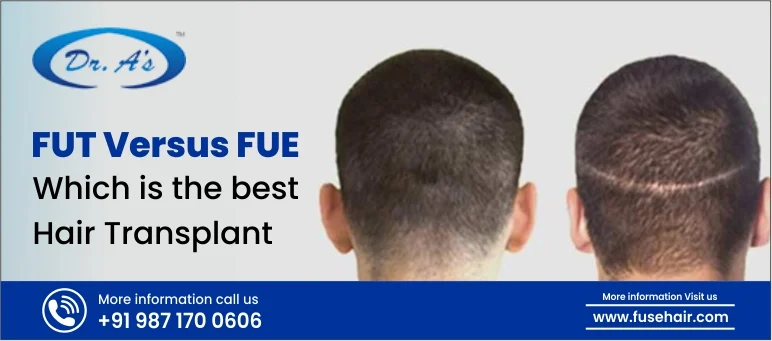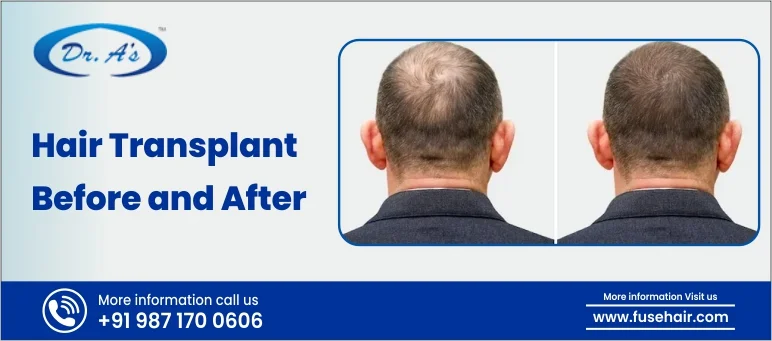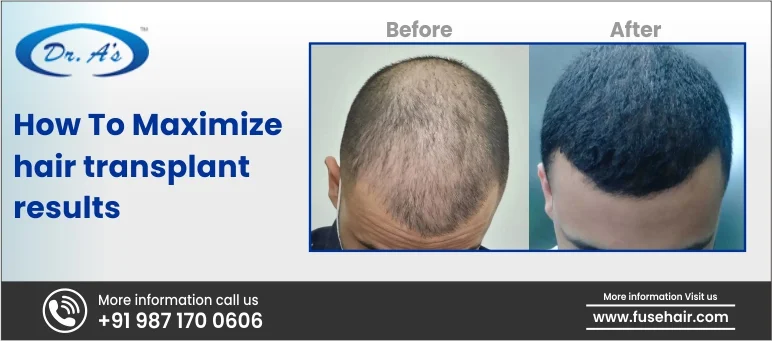
Are you eagerly wanting to get a hair transplant and build your confidence back? Well! If you are confused and have no idea which method to opt for, we can give you some knowledge on “FUT versus FUE.
If you are considering a hair transplant to deal with balding, then such kind of treatment is already the choice of many people. Researchers have shown that about 85% of men and a little over half (40%) of women suffer hair loss during their lifetime. Hair restoration is considered an excellent opportunity to achieve dense mane.
There are different types of hair transplant processes available and your doctor can suggest the technique that suits your condition. However, the most common techniques for the transplantation of hair roots are FUE and FUT. There are significant differences between the two techniques, but both of them can work well and make your hair thicker & curlier.
At Dr. A’s Clinic, we have helped over 10,000 men and women struggling with hair loss around the country and even worldwide. Led by certified physician Dr. Arvind Poswal, the “Father of Hair Transplants in India, “our care team carefully evaluates the patient’s scalp and discusses the goals before creating a tailored hair restoration plan for them.
If the prospect of a hair transplant intrigues you, continue reading to discover the differences between FUE and FUT procedures. This article can help you determine which yields the most favorable results as per your condition.
About FUE hair transplant
The FUE (Follicular Unit Excision) technique is a contemporary approach to hair transplantation. It involves extracting individual hair follicles from the back of the scalp using small punches. These grafts are then delicately placed into small incisions made at the recipient site, where the new hair is intended to grow. Following the FUE hair transplant procedure, the scalp is typically bandaged for a few days. Although the transplanted hair initially falls out, regrowth typically begins around three to four months later.
Who needs FUE?
Men experiencing thinning hair or balding at the top or front of their heads need to go for FUE. The success of this procedure relies on the density and stability of the hair in the donor area at the back of the head.
FUE serves as an excellent alternative for individuals who may not be suitable candidates for FUT. This includes those with minimal hair in the donor area or individuals with a soft scalp.
Positive points of FUE:
High-Quality Grafts
The new technology in the FUE process utilizes computerized technology and conducts real-time 3D analysis and assessment of each hair follicle’s characteristics. This enables the robot to meticulously select the healthiest and strongest follicles for successful harvesting and transplantation.
Natural-Looking Results
The FUE method gathers and transplants hairs in their natural groupings, leaving no linear scar. This results in a more natural appearance, allowing you the flexibility to wear your hair as short as you desire without concern about visible scarring.
Pain-Free Experience
FUE procedure employs local anesthesia to ensure minimal discomfort throughout the process. The minimally invasive nature of FUE often leads to minimal pain both during and after the procedure, enhancing patient comfort.
Swift Recovery
With no need for a scalpel or stitches, the recovery period after an FUE transplant is brief, with many individuals resuming their regular activities within a couple of days. The entire procedure typically takes only about 8 hours, contributing to a quicker recovery.
Minimal Donor Area Scarring
The random harvesting of follicles in FUE minimally impacts the appearance and density of the donor area. FUE is an ideal choice for those who prefer very short hairstyles, as the donor area remains unaffected and unaltered.
About FUT hair transplant
The FUT (Follicular Unit Transplantation, or linear strip excision) technique involves harvesting hair grafts by removing a strip of skin from the back of your scalp, typically several inches long. After stitching up the donor site, the strip is divided into smaller sections using a surgical tool. These smaller sections are then implanted at the recipient site, initiating the process of hair renewal. Following transplantation, the initial follicles fall out, paving the way for permanent follicles to grow in their place over a period of around three to four months.
Who needs FUT?
When a patient aims for maximum fullness in hair restoration, FUT is the recommended choice. For individuals dealing with pronounced balding around the crown area, FUT can offer a more effective solution than FUE, providing enhanced coverage and fullness.
Positive points of FUT:
Manageable Recovery Time:
The recovery time for a FUT procedure is typically quite manageable, lasting around 10-12 days. While some patients may experience slightly higher discomfort due to potential swelling from the scalp strip removal, prescribed pain medication helps alleviate any discomfort.
Higher Rate Of Follicle Survival:
FUT harvests hair from the mid-donor zone, where hair is more permanent. This makes FUT a recommended option for patients with limited hair availability in the donor area. The meticulous harvesting of follicles in FUT preserves protective tissue, resulting in robust and higher-quality grafts.
Natural Looking Results:
The procedure leaves a thin, linear scar, usually no more than 1mm in diameter. This scar is easily concealed by surrounding hair, rendering it virtually undetectable. In a FUT hair transplant, hair is transplanted in small, naturally occurring groups of 1-4 hairs, ensuring a fuller, natural-looking result without revealing the transplant.
No Additional Scarring With Subsequent Sessions:
Regardless of the number of FUT procedures a patient undergoes, only one scar remains. In contrast, the FUE procedure leaves a small, round scar with each harvested follicle, potentially resulting in additional scarring with multiple sessions.
FUT Versus FUE at a glance
| Characteristics | FUT | FUE |
| Shaving or Trimming of Head | Not Required | Required |
| Cost of Hair Transplantation | Economical | Relatively Costly |
| Suitability for Large Areas | Possible | Challenging |
| Necessity for Stitches | Yes | No |
| Visibility of Scarring with Short Hair | Possible Presence | Small Dot-Like Scars |
| Post-Procedure Pain Level | Minor | Negligible |
| Procedure Duration | Swift | Prolonged |
| Healing Time for Donor Area | 2-3 Weeks | Approximately 1 Week |
| Healing Time for Recipient Area | About 2 Weeks | 10–14 Days |
| Time to Resume Work | Next Day | Usually Next Day, with Some Discomfort for 2 Weeks |
| Achieving Natural Results | Affirmative | Yes |
| Transaction Rate (Grafts Damaged During Extraction) | Varies (1–2%) | 2-5% |
Conclusion
Carrying out the process of transplantation and choosing a technique depends on the patient’s need, seeing that every patient differs from one another. That’s why the team at Dr. A’s clinic, led by experienced surgeons Dr. Arvind and Dr. Raghav Poswal, is here to assist you. We provide individual consultation sessions, where you can get acquainted with us face-to-face and receive answers to all possible questions regarding your needs. During this process, we check patients’ hair follicles to establish the appropriate graftings and direct you to viable techniques in consideration with either FUE or FUT hair implants depending on severity. With confidence, it should be stated that our clinic does different hair transplants by experienced surgeons equipped with the latest technology.
FAQ’s
-
What is the success rate of FUE vs FUT?
Percentages of success in FUE and FUT are both above 90%, although it depends on the particular case, as well as the level of skills that a surgeon applies. FUE is well-defined as a procedure that leaves very little scarring, improves faster recovery rates, and also processes smaller donor sites which quantify its prevalence among people who wish to maintain a shorter hair style. Alternatively, although FUT has a similar success rate as the rest of the treatments addressed in this chapter with its linear scar and slightly longer healing period it is preferred for larger transplants. The final outcome for either of these procedures, however, is determined by the patient’s particular needs as well as surgical skills and recent technological aspects such as robotic assistance improving success rates in both FUE and FUT. The outcome largely depends on the expertise, knowledge, and experience of the performing doctor. Dr. A’s Clinic with expert doctors has always been able to achieve a 100 percent success rate.
-
Which hair transplant is the best?
Opting between FUT and FUE hair transplant procedures largely depends on various factors, which a doctor will discuss with the patient during a consultation. Typically, patients with more extensive hair thinning problems, requiring a larger number of grafts, may find FUT (Follicular Unit Transplantation, or linear strip excision) more suitable due to its higher yield of follicles. On the other hand, FUE (Follicular Unit Excision) might be a better option for those needing fewer grafts or want a quicker return to daily activities, as its less invasive nature often results in a shorter recovery time. Doctors will assess the specific needs of patients, considering factors such as the number and quality of required grafts, as well as the availability of donor hair, to determine the most suitable procedure for the hair transplant.
-
Which hair transplant is the safest?
Since the FUE transplant involves a less invasive approach, most patients feel little to no pain during or after the procedure. Without the use of a scalpel or stitches, the recovery period following an FUE transplant is speedy, allowing many individuals to resume their regular activities within a few days. It is, therefore, the safest and most popular choice for doctors as well as patients around the world.
-
What is the best hair transplant method in 2024?
FUE is the most common and popular procedure for hair transplants in 2024. It works well when covering a large surface but does not leave much noticeable evidence because hair is removed individually. FUE transplants have a success rate, boasting graft survival rates of 90%. When utilizing the latest Robotic FUE technology, the procedure’s success rate can reach an impressive 100%. The data above can be considered to call FUE a better method. There could be slight scars, although they normally are not visible. It is a very efficient treatment and most respond well to it. However, again it all depends on the patient’s needs and the doctor’s suggestion. A surgeon will be able to guide a patient best in choosing FUT and FUE after examining them.
-
Is it Possible for an Individual to Undergo Both FUT and FUE?
Certainly. First, FUT may be used to maximize the yield of the first procedure(s). But in later sessions, the scalp becomes too tight to allow for additional FUT/strip surgeries or the donor scar may expand more than anticipated. In the latter case, the transition to FUE can be done in subsequent sessions. In the former instance, such a surgeon can harvest follicular units through FUE and tunnel them into an expanding scar to hide it.
However, in case the initial procedure is FUE and if yield fails to reach a satisfactory level for their doctor’s criteria, patients may consider switching it to an alternative strategy of operation like FUT either through that particular surgery or future ones.
-
What is the Cost of a Hair Transplant?
When considering a hair restoration procedure, a common question that most people ask is about the expense involved. It is important to note that there is no set cost for hair transplants, and the average expense can fluctuate significantly. The calculation of most hair transplant costs is based on the number of grafts that are required to cover the area affected by thinning hair. The ultimate hair transplant cost is influenced by factors such as the stage of your hair loss progression and the specific type of procedure chosen.






